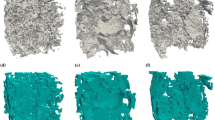Abstract
A new approach to analytical and numerical study of the process of the post-glacial uplifting of the Earth’s surface was proposed within the framework of a viscous model. Displacement of the Earth’s surface is considered as the motion of the density boundary due to chemico-density convection. It is shown that the incorporation of the non-Newtonian rheology at observed velocities of post-glacial uplifts requires an obligatory presence of faults in the lithosphere and gives rise to quasi-uniform motion of the mantle material, whose viscosity under the lithosphere is, on the average, sufficiently small and amounts to ∼1019 Pa. The study of the stability of the constructed model of the post-glacial uplift considered as the chemico-density convection relative to the thermal convection shows that the velocity of thermal convection developing in the presence of a quasiuniform mantle flow related to the post-glacial recovery is ∼1 m/yr.
Similar content being viewed by others
References
L. M. Cathles, The Viscosity of the Earth’s Mantle (Prinston University Press, Prinston, New Jersey, 1975).
U. Christensen, “An Eulerian Technique for Thermomechanical Modeling of Lithospheric Extensions,” J. Geophys. Res. 97, 2015 (1992).
L. M. Flesch, W. E. Holt, A. J. Haines, and B. Shen-Tu, “Dynamics of the Pacific-North American Plate Boundary in the Western United States,” Science 287, 834 (2000).
S. V. Gavrilov, “Emplacement of Thermal Diapires into a Continental Lithospheric Plate from the Non-Newtonian Upper Mantle,” Fizika Zemli, No. 7–8, 18 (2003) [Izvestiya, Physics of the Solid Earth 30 (7/8) (1995).
L. D. Landau and K. M. Lifshits, Hydrodynamics (Nauka, Moscow, 1986) [in Russian].
G. A. Milne, G. I. Davis, J. X. Mitrovica, et al., “Space-Geodetic Constraints on Glacial Isostatic Adjustment in Fennoscandia,” Science 291, 2381 (2001).
G. Schubert, D. L. Turcotte, and P. Olson, Mantle Convection in the Earth and Planets (Cambridge Univ. Press, New York, 2001).
D. L. Turcotte and G. Schubert Geodynamics: Applications of Continuum Physics to Geological Problems (Cambridge Univ. Press, New York, 2002).
A. M. Tushingham and W. R. J. Peltier, “A new Global Model for the Pleistocene Deglaciation Based upon Geophysical Predictions of Relative Sea Level Changes,” Geophys. Res. 96, 4497 (1991).
V. S. Vladimirov, Equations of Mathematical Physics (Nauka, Moscow, 1988) [in Russian].
P. Wheeler and N. White, “Quest for Dynamic Topography: Observations from Southeast Asia,” Geology, 28, 963 (2000).
V. N. Zharkov, Geophysical Study of Planets and Satellites (OIFZ RAS, Moscow, 1975) [In Russian].
Author information
Authors and Affiliations
Additional information
Original Russian Text © S.V. Gavrilov, 2009, published in Fizika Zemli, 2009, No. 5, pp. 70–76.
Rights and permissions
About this article
Cite this article
Gavrilov, S.V. Convection model of post-glacial uplift. Izv., Phys. Solid Earth 45, 437–443 (2009). https://doi.org/10.1134/S1069351309050073
Received:
Published:
Issue Date:
DOI: https://doi.org/10.1134/S1069351309050073




